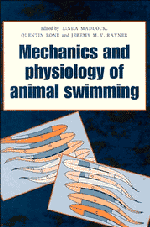Book contents
- Frontmatter
- Contents
- Contributors
- Introduction
- 1 Functional patterns of swimming bacteria
- 2 Buoyancy and swimming in marine planktonic protists
- 3 The role of fins in the competition between squid and fish
- 4 The biology of fish swimming
- 5 Swimming physiology of pelagic fishes
- 6 The mechanical design of the fish muscular system
- 7 How do fish use their myotomal muscle to swim? In vitro simulations of in vivo activity patterns
- 8 The timing of lateral muscle strain and EMG activity in different species of steadily swimming fish
- 9 Swimming in the lamprey: modelling the neural pattern generation, the body dynamics and the fluid mechanics
- 10 Swimming capabilities of Mesozoic marine reptiles: a review
- 11 Stone, bone or blubber? Buoyancy control strategies in aquatic tetrapods
- 12 Functional anatomy of the ‘flight’ apparatus in penguins
- 13 Energy conservation by formation swimming: metabolic evidence from ducklings
- Bibliography
- Index
7 - How do fish use their myotomal muscle to swim? In vitro simulations of in vivo activity patterns
Published online by Cambridge University Press: 05 March 2012
- Frontmatter
- Contents
- Contributors
- Introduction
- 1 Functional patterns of swimming bacteria
- 2 Buoyancy and swimming in marine planktonic protists
- 3 The role of fins in the competition between squid and fish
- 4 The biology of fish swimming
- 5 Swimming physiology of pelagic fishes
- 6 The mechanical design of the fish muscular system
- 7 How do fish use their myotomal muscle to swim? In vitro simulations of in vivo activity patterns
- 8 The timing of lateral muscle strain and EMG activity in different species of steadily swimming fish
- 9 Swimming in the lamprey: modelling the neural pattern generation, the body dynamics and the fluid mechanics
- 10 Swimming capabilities of Mesozoic marine reptiles: a review
- 11 Stone, bone or blubber? Buoyancy control strategies in aquatic tetrapods
- 12 Functional anatomy of the ‘flight’ apparatus in penguins
- 13 Energy conservation by formation swimming: metabolic evidence from ducklings
- Bibliography
- Index
Summary
In a number of laboratories, the mechanical properties of myotomal muscle are being investigated under conditions which approximate to those believed to be operating in vivo during steady swimming. The aim of these studies is to learn how myotomal muscle is used to generate swimming movements. To perform these experiments, the muscle length changes during steady swimming (the strain cycle) and the pattern of muscle activation (activation cycle) must be known. Electromyographical (EMG) recordings from several points along the length of swimming fish have provided information on the activation cycles. Strain cycles of superficial muscle fibres have to date been determined primarily by calculation from the changes in shape of the fish plan outline. Simultaneous EMG and kinematic analyses yield the relation between strain and activation cycles. By imposing cyclical strains on isolated muscle, and stimulating at different phases in the strain cycle, a wide range of possible in vivo situations can be simulated, and muscle performance under these conditions can be compared to values under conditions which yield, for example, maximum power, work or stress. Valuable insights are thus gained into design constraints and the mechanisms by which muscle function has been optimized by selective pressures.
INTRODUCTION
An answer to the question posed by this paper is still some way in the future. However, recent investigations which draw on both in vivo studies of swimming fish and in vitro experiments on isolated muscle fibres, are shedding some light on the problem. To understand the functional role of myotomal muscle, we need to know the conditions under which it is operating in vivo, and its mechanical performance under these conditions.
- Type
- Chapter
- Information
- The Mechanics and Physiology of Animal Swimming , pp. 99 - 110Publisher: Cambridge University PressPrint publication year: 1994
- 2
- Cited by



